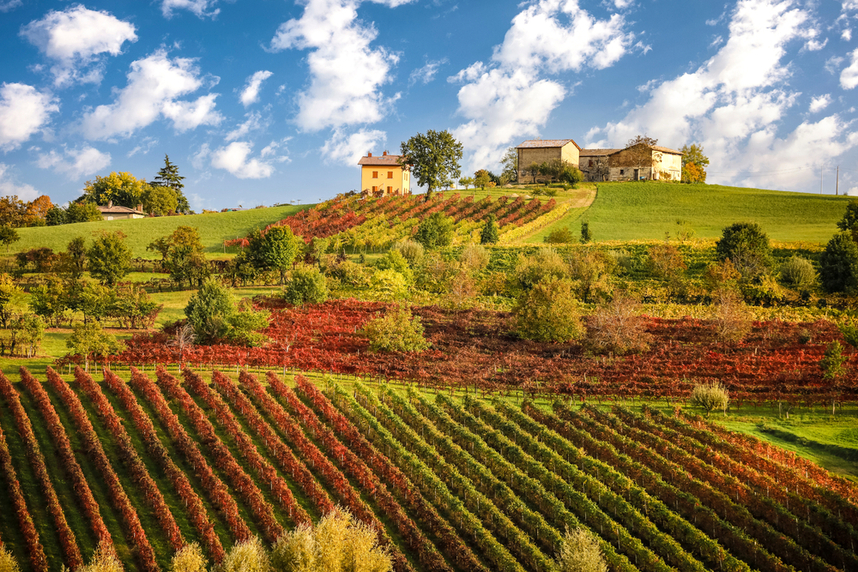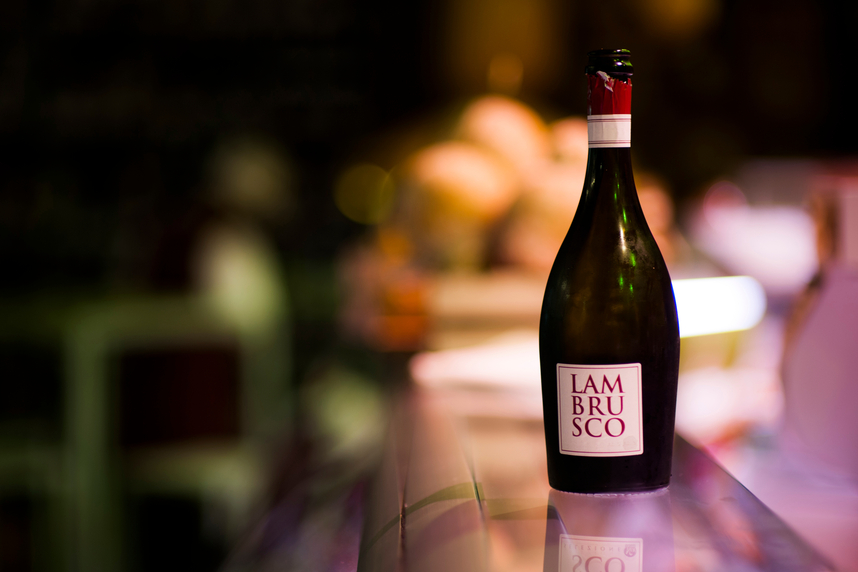From antiquity to the present day: the story of the rise of Lambrusco
Emilia-Romagna has been a region dedicated to the cultivation of vines since the Bronze Age. The domestication of these plants is historically proven by the discovery of some seeds in the main areas where Lambrusco wine is produced today.
It was mainly the Latin authors who acted as a sounding board for the fame of this wine (or rather, its ancestor). In the works of Cato, Virgil, Varro and Pliny the Elder, mention is in fact made - under the name of vitis labrusca - of a wild variety that grew in the Campania region and gave farmers excellent wines.
In the centuries that followed, this wine experienced an enormous fortune, thanks to more conscious cultivation techniques in the Renaissance period, as well as the strengthening of winemaking processes in the 18th and 19th centuries. In 1814, Vincenzo Dandolo, a count and agronomist, studied and shared new theories for the bottling of sparkling wines and their correct preservation in written form, thus marking a fundamental turning point for the marketing of Lambrusco throughout the Italian peninsula and abroad.
The enormous fame of this sparkling wine from Emilia-Romagna made it necessary to set up a project to protect growers, producers and processes: thus it was that the history of Lambrusco underwent a further turning point, with the birth in 1961 of the Consortium of Lambrusco Wines, followed in 1970 by the obtaining of the regional DOC. Which was, however, only the first of many.
Lambrusco, one wine, many appellations: production areas and characteristics
Although Lambrusco production is not confined to a single region (the Lambrusco Mantovano DOC denomination testifies to its encroachment into Lombardy), it is in Emilia-Romagna that its best-known declinations are to be found.
The Lambrusco production area, delimited by the provinces of Modena, Reggio Emilia and Parma, has features common to all three areas, with some minor differences. The climate is continental or subcontinental, with very hot summers and cold winters, both characterised by a fair degree of humidity.
Rainfall is mainly concentrated in spring and autumn, and is scarce in the most extreme months. While in the province of Modena the soils are mainly clayey and compact, in the Reggio Emilia area the alluvial soils with gravelly surface layers give the Lambrusco vines a good mineral supply.
These conditions - as well as the care and experience of the growers - give rise to different types of Lambrusco DOC.
- Lambrusco di Sorbara DOCproduced in the province of Modena from varieties of Lambrusco di Sorbara (min. 60%), Lambrusco Salamino di Santa Croce (max. 40%) and a low percentage of other Lambruscos and Uva d'Oro winerosy tones and considerable elegance, characterised by a slightly accentuated tannicity that makes it an easy-drinking product. Its olfactory notes are dominated by the suave scents of red fruits and violets, while on the palate it is fresh and delicate, thanks to a persistent mousse.
- Lambrusco Grasparossa di Castelvetro DOCa Modenese wine of noble extraction and gritty character, produced from 85% Lambrusco Grasparossa grapes and a small percentage made up of other Lambruscos and Malbo Gentile
Immediately stands out on visual inspection is its intense ruby red colour with violet hues, as well as the persuasive intensity of its aromas of violets and red fruits, with a slight hint of almond. Compared to Sorbara, this variety displays more pronounced tannins and an acidic taste that lends character to the tasting.
- Lambrusco Salamino di Santa Croce DOC: This wine from the province of Modena is produced from 85% of the vine of the same name and 15% other Lambruscos. It flaunts an intense red hue in the glass, anticipating an equally gritty character.
The olfactory examination is dominated by heady aromas of red fruits, with light hints of rose, while the palate is savoury and lively, not excessively tannic and with a full-bodied effervescence.
- Lambrusco Colli di Scandiano e di Canossa DOC: grown and vinified in the province of Reggio Emilia from 85% of vines that vary from producer to producer. An elegant and pleasantly drinkable wine, with a floral and fruity organoleptic profile. On the palate it is fresh and harmonious, able to please everyone with its light mousse.
- Lambrusco di Modena DOC: the Modenese Lambrusco par excellence can be produced 85% from Grasparossa, Salamino, Sorbara, Marani, Maestri, Montericco, Oliva or jagged-leaf Lambrusco varieties, while the remaining 15% is made from Ancellotta, Fortana and Malbo Gentile.
Multifaceted and versatile, Modena DOC comes in different shades,from rosé to deep red, and tickles the nose with fruity and floral notes. On tasting, the palate is captivated by a refreshing effervescence and slightly acidic finish.
- Lambrusco Reggiano DOC: many grape varieties are involved in the production of this wine, giving rise to different nuances from one winery to another. Reggiano DOC presents itself to the glass in an elegant red guise, and conquers those who taste it with lively fruity notes and a biting effervescence.
Gastronomic pairings with Lambrusco: Make way for Emilian dishes!
If it is true that Lambrusco is one of Emilia-Romagna's most representative wines, it goes without saying that at the table, the most perfect pairings are precisely those that feature the region's dishes, from the most intense to the most delicate, from seafood recipes to delicious land-based preparations.
For delicious traditional hors d'oeuvres, such as piadina romagnola and gnocco fritto, one can go for a glass of Lambrusco Sorbara DOC, which lightens the full-bodied nature of the ingredients used (as well as the heaviness of frying) with a delicate soul and pleasant floral hints. Thanks to the persistent and lively effervescence, the characteristics of Lambrusco Reggiano DOC also go well with fried preparations and cured meats.
Faced with the tastiest peaks of Emilian cuisine - we are of course talking about lasagne alla Bolognese and fresh filled pasta, even in broth - Lambrusco Grasparossa di Castelvetro DOC makes an excellent impression, worthily flanking even the most full-bodied sauces thanks to its equally structured identity and considerable tannic component.
The ideal companion for red or white meat dishes, on the other hand, is Salamino Santa Croce DOC, capable on the one hand of accompanying the tastiest ingredients without being overshadowed by them, and on the other of enhancing the most delicate recipes by giving them a lively touch. A Sorbara, on the other hand, is excellent with fish dishes.
Gastronomic pairings with Lambrusco can only end with dessert. Both traditional Emilian desserts (busslanein, zabaglione and cakes of various kinds) and international pastries call for Lambrusco wines that are either sweet or sweet (it matters little which type), which create a harmony of flavours thanks to their persuasive - but never excessive - sugar content.
Lambrusco, some curiosities

Vitis labrusca. This is how the Romans defined the wild plants from which today's Lambrusco is derived, thus giving rise to the first real curiosity in the history of this wine. According to the most accredited hypothesis on the etymology of the term, labrusca would derive from the union of labrum, or edge, and ruscum, wild. A word that therefore came to identify a spontaneous and rustic vine that grew on the edges of the countryside.
There is also a legend about Lambrusco, dating back to the 11th century, when Matilda of Canossa, supporter of the papacy, found an alternative method to win the battle of Sorbara, fought against the imperial armies. She left some Lambrusco at the castle of Sorbara, which was taken by the enemies, who drank it and fell asleep in a drunken stupor, thus bringing about their defeat.
The value of Lambrusco has not prevented it over the centuries from also being a wine suitable for the people. Another interesting curiosity concerns its pleasantness and versatility. Not only was it a popular wine in taverns, but its second pressing (which gave rise to the so-called torchiato) was consumed as an invigorating drink by workers in the countryside, diluted with water.
In the 1970s and 1980s, Lambrusco was also so popularly exported and drunk in the United States that it was nicknamed 'Italian Coca-Cola'.
Now that you know all about Lambrusco, don't miss the selection of bottles in the Svinando catalogue!

